CITROEN C5 AIRCROSS DAG 2020 Handbook (in English)
Manufacturer: CITROEN, Model Year: 2020, Model line: C5 AIRCROSS DAG, Model: CITROEN C5 AIRCROSS DAG 2020Pages: 292, PDF Size: 8.59 MB
Page 101 of 292
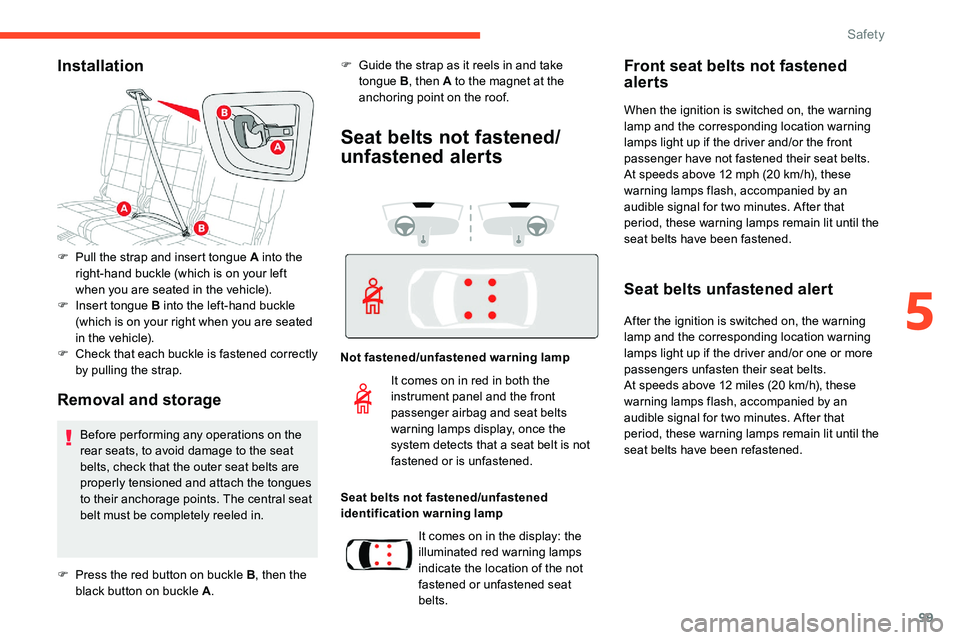
99
Installation
Removal and storage
F Pull the strap and insert tongue A into the right-hand buckle (which is on your left
when you are seated in the vehicle).
F
In
sert tongue B into the left-hand buckle
(which is on your right when you are seated
in the vehicle).
F
C
heck that each buckle is fastened correctly
by pulling the strap. F
G
uide the strap as it reels in and take
tongue B , then A to the magnet at the
anchoring point on the roof.
Before per forming any operations on the
rear seats, to avoid damage to the seat
belts, check that the outer seat belts are
properly tensioned and attach the tongues
to their anchorage points. The central seat
belt must be completely reeled in.
Seat belts not fastened/
unfastened alerts
Not fastened/unfastened warning lamp Seat belts not fastened/unfastened
identification warning lamp
Front seat belts not fastened
alerts
When the ignition is switched on, the warning
lamp and the corresponding location warning
lamps light up if the driver and/or the front
passenger have not fastened their seat belts.
At speeds above 12 mph (20 km/h), these
warning lamps flash, accompanied by an
audible signal for two minutes. After that
period, these warning lamps remain lit until the
seat belts have been fastened.
F
P
ress the red button on buckle B , then the
black button on buckle A . It comes on in red in both the
instrument panel and the front
passenger airbag and seat belts
warning lamps display, once the
system detects that a
seat belt is not
fastened or is unfastened.
It comes on in the display: the
illuminated red warning lamps
indicate the location of the not
fastened or unfastened seat
belts.
Seat belts unfastened alert
After the ignition is switched on, the warning
lamp and the corresponding location warning
lamps light up if the driver and/or one or more
passengers unfasten their seat belts.
At speeds above 12 miles (20 km/h), these
warning lamps flash, accompanied by an
audible signal for two minutes. After that
period, these warning lamps remain lit until the
seat belts have been refastened.
5
Safety
Page 102 of 292
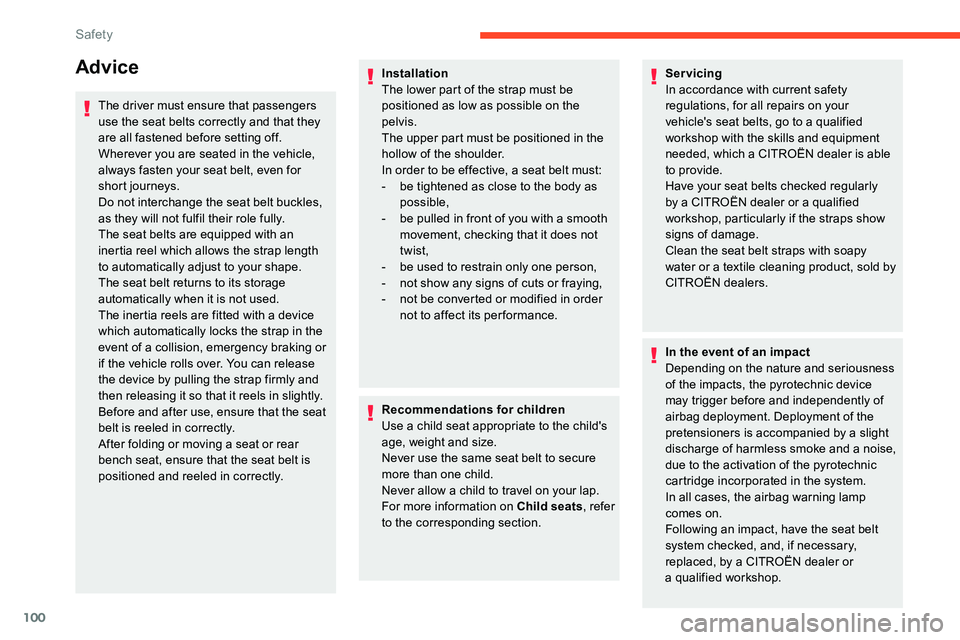
100
Advice
The driver must ensure that passengers
use the seat belts correctly and that they
are all fastened before setting off.
Wherever you are seated in the vehicle,
always fasten your seat belt, even for
short journeys.
Do not interchange the seat belt buckles,
as they will not fulfil their role fully.
The seat belts are equipped with an
inertia reel which allows the strap length
to automatically adjust to your shape.
The seat belt returns to its storage
automatically when it is not used.
The inertia reels are fitted with a device
which automatically locks the strap in the
event of a
collision, emergency braking or
if the vehicle rolls over. You can release
the device by pulling the strap firmly and
then releasing it so that it reels in slightly.
Before and after use, ensure that the seat
belt is reeled in correctly.
After folding or moving a
seat or rear
bench seat, ensure that the seat belt is
positioned and reeled in correctly. Installation
The lower part of the strap must be
positioned as low as possible on the
pelvis.
The upper part must be positioned in the
hollow of the shoulder.
In order to be effective, a seat belt must:
-
b
e tightened as close to the body as
possible,
-
b
e pulled in front of you with a smooth
movement, checking that it does not
twist,
-
b
e used to restrain only one person,
-
n
ot show any signs of cuts or fraying,
-
n
ot be converted or modified in order
not to affect its per formance.
Recommendations for children
Use a
child seat appropriate to the child's
age, weight and size.
Never use the same seat belt to secure
more than one child.
Never allow a
child to travel on your lap.
For more information on Child seats , refer
to the corresponding section. Servicing
In accordance with current safety
regulations, for all repairs on your
vehicle's seat belts, go to a
qualified
workshop with the skills and equipment
needed, which a
CITROËN dealer is able
to provide.
Have your seat belts checked regularly
by a
CITROËN dealer or a qualified
workshop, particularly if the straps show
signs of damage.
Clean the seat belt straps with soapy
water or a
textile cleaning product, sold by
CITROËN dealers.
In the event of an impact
Depending on the nature and seriousness
of the impacts, the pyrotechnic device
may trigger before and independently of
airbag deployment. Deployment of the
pretensioners is accompanied by a
slight
discharge of harmless smoke and a
noise,
due to the activation of the pyrotechnic
cartridge incorporated in the system.
In all cases, the airbag warning lamp
comes on.
Following an impact, have the seat belt
system checked, and, if necessary,
replaced, by a
CITROËN dealer or
a
qualified workshop.
Safety
Page 103 of 292
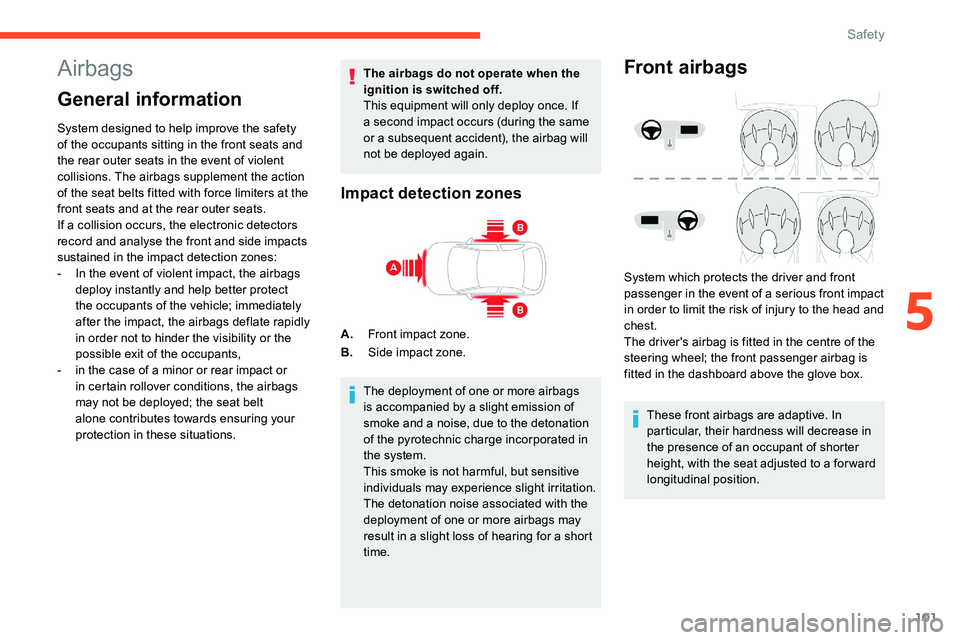
101
Airbags
General information
System designed to help improve the safety
of the occupants sitting in the front seats and
the rear outer seats in the event of violent
collisions. The airbags supplement the action
of the seat belts fitted with force limiters at the
front seats and at the rear outer seats.
If a collision occurs, the electronic detectors
record and analyse the front and side impacts
sustained in the impact detection zones:
-
I
n the event of violent impact, the airbags
deploy instantly and help better protect
the occupants of the vehicle; immediately
after the impact, the airbags deflate rapidly
in order not to hinder the visibility or the
possible exit of the occupants,
-
i
n the case of a minor or rear impact or
in certain rollover conditions, the airbags
may not be deployed; the seat belt
alone contributes towards ensuring your
protection in these situations. The airbags do not operate when the
ignition is switched off.
This equipment will only deploy once. If
a
second impact occurs (during the same
or a subsequent accident), the airbag will
not be deployed again.
Impact detection zones
A. Front impact zone.
B. Side impact zone.
The deployment of one or more airbags
is accompanied by a
slight emission of
smoke and a
noise, due to the detonation
of the pyrotechnic charge incorporated in
the system.
This smoke is not harmful, but sensitive
individuals may experience slight irritation.
The detonation noise associated with the
deployment of one or more airbags may
result in a
slight loss of hearing for a short
time.
Front airbags
System which protects the driver and front
passenger in the event of a serious front impact
in order to limit the risk of injury to the head and
chest.
The driver's airbag is fitted in the centre of the
steering wheel; the front passenger airbag is
fitted in the dashboard above the glove box.
These front airbags are adaptive. In
particular, their hardness will decrease in
the presence of an occupant of shorter
height, with the seat adjusted to a
for ward
longitudinal position.
5
Safety
Page 104 of 292
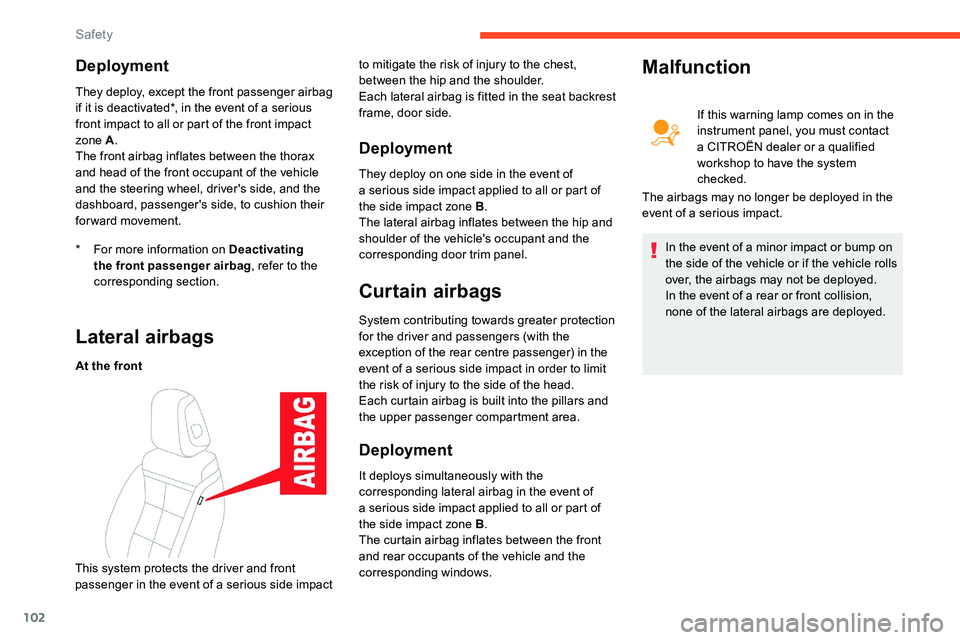
102
Deployment
* For more information on Deactivating the front passenger airbag , refer to the
corresponding section.
They deploy, except the front passenger airbag
if it is deactivated*, in the event of a
serious
front impact to all or part of the front impact
zone A .
The front airbag inflates between the thorax
and head of the front occupant of the vehicle
and the steering wheel, driver's side, and the
dashboard, passenger's side, to cushion their
for ward movement.
Lateral airbags
At the front
Deployment
They deploy on one side in the event of
a serious side impact applied to all or part of
the side impact zone B .
The lateral airbag inflates between the hip and
shoulder of the vehicle's occupant and the
corresponding door trim panel.
Curtain airbags
System contributing towards greater protection
for the driver and passengers (with the
exception of the rear centre passenger) in the
event of a
serious side impact in order to limit
the risk of injury to the side of the head.
Each curtain airbag is built into the pillars and
the upper passenger compartment area.
Deployment
It deploys simultaneously with the
corresponding lateral airbag in the event of
a
serious side impact applied to all or part of
the side impact zone B .
The curtain airbag inflates between the front
and rear occupants of the vehicle and the
corresponding windows.
Malfunction
If this warning lamp comes on in the
instrument panel, you must contact
a
CITROËN dealer or a qualified
workshop to have the system
checked.
The airbags may no longer be deployed in the
event of a
serious impact.
In the event of a
minor impact or bump on
the side of the vehicle or if the vehicle rolls
over, the airbags may not be deployed.
In the event of a
rear or front collision,
none of the lateral airbags are deployed.
This system protects the driver and front
passenger in the event of a
serious side impact to mitigate the risk of injury to the chest,
between the hip and the shoulder.
Each lateral airbag is fitted in the seat backrest
frame, door side.
Safety
Page 105 of 292

103
Advice
For the airbags to be fully effective,
observe the safety recommendations
below.
Adopt a normal and upright sitting
position.
Wear a
correctly adjusted seat belt.
Do not leave anything between the
occupants and the airbags (a child, pet,
object, etc.), nor fix or attach anything
close to or in the way of the airbag release
trajectory; this could cause injuries during
their deployment.
Never modify the original definition of your
vehicle, particularly in the area directly
around the airbags.
After an accident or if the vehicle has
been stolen, have the airbag systems
checked.
All work on the airbag systems must only
be carried out by a
CITROËN dealer or
a
qualified workshop.
Even if all of the precautions mentioned
are obser ved, a risk of injury or of minor
burns to the head, chest or arms cannot
be ruled out when an airbag is deployed.
The bag inflates almost instantly (within
a
few milliseconds) then deflates within
the same time discharging the hot gas via
openings provided for this purpose. Front airbags
Do not drive holding the steering wheel
by its spokes or resting your hands on the
centre part of the wheel.
Passengers must not place their feet on
the dashboard.
Do not smoke as deployment of the
airbags can cause burns or the risk of
injury from a
cigarette or pipe.
Never remove or pierce the steering wheel
or hit it violently.
Do not fix or attach anything to the
steering wheel or dashboard, as this
could cause injuries when the airbags are
deployed.
Curtain airbags
Do not fix or attach anything to the roof,
as this could cause head injuries when the
curtain airbag is deployed. Lateral airbags
Use only approved covers on the seats,
compatible with the deployment of the
lateral airbags. For information on the
range of seat covers suitable for your
vehicle, contact the CITROËN network.
Do not fix or attach anything to the seat
backrests (clothes, etc.), as this could
cause injuries to the thorax or arm when
the lateral airbag is deployed.
Do not sit with the upper part of the body
any nearer to the door than necessary.
The vehicle's front door panels include
side impact sensors.
A damaged door or any unauthorised or
incorrectly executed work (modification or
repair) on the front doors or their interior
trim could compromise the operation of
these sensors – risk of malfunction of the
lateral airbags!
Such work must only be done by
a
CITROËN dealer or a qualified
workshop.
5
Safety
Page 106 of 292
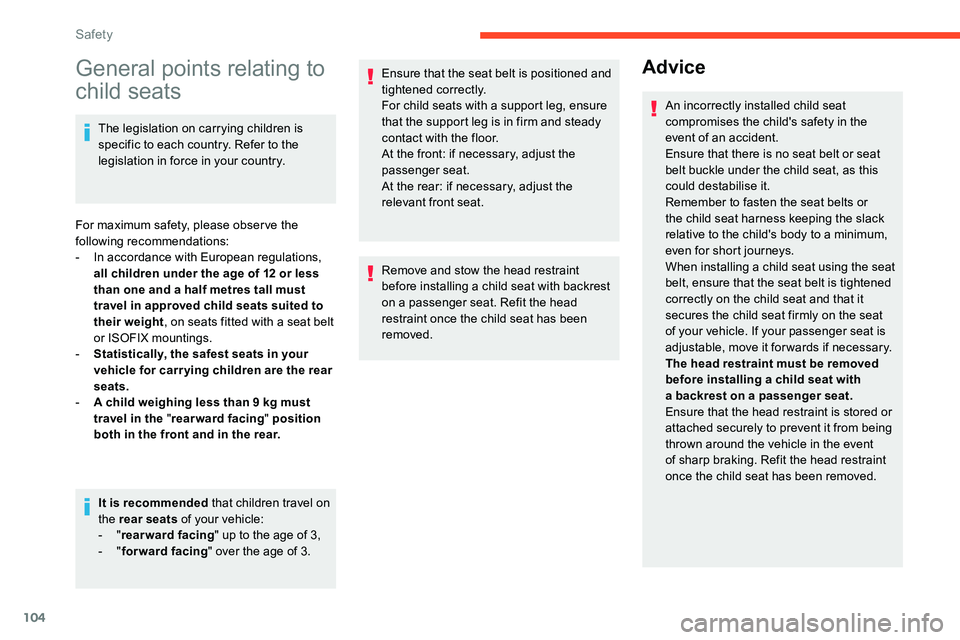
104
General points relating to
child seats
The legislation on carrying children is
specific to each country. Refer to the
legislation in force in your country.
For maximum safety, please obser ve the
following recommendations:
-
I
n accordance with European regulations,
all children under the age of 12
or less
than one and a
half metres tall must
travel in approved child seats suited to
their weight , on seats fitted with a
seat belt
or ISOFIX mountings.
-
S
tatistically, the safest seats in your
vehicle for carr ying children are the rear
seats.
-
A c
hild weighing less than 9 kg must
travel in the " rearward facing " position
both in the front and in the rear.
It is recommended that children travel on
the rear seats of your vehicle:
-
"rearward facing " up to the age of 3,
-
"forward facing " over the age of 3. Ensure that the seat belt is positioned and
tightened correctly.
For child seats with a
support leg, ensure
that the support leg is in firm and steady
contact with the floor.
At the front: if necessary, adjust the
passenger seat.
At the rear: if necessary, adjust the
relevant front seat.
Remove and stow the head restraint
before installing a
child seat with backrest
on a
passenger seat. Refit the head
restraint once the child seat has been
removed.
Advice
An incorrectly installed child seat
compromises the child's safety in the
event of an accident.
Ensure that there is no seat belt or seat
belt buckle under the child seat, as this
could destabilise it.
Remember to fasten the seat belts or
the child seat harness keeping the slack
relative to the child's body to a
minimum,
even for short journeys.
When installing a
child seat using the seat
belt, ensure that the seat belt is tightened
correctly on the child seat and that it
secures the child seat firmly on the seat
of your vehicle. If your passenger seat is
adjustable, move it forwards if necessary.
The head restraint must be removed
before installing a
child seat with
a
backrest on a passenger seat.
Ensure that the head restraint is stored or
attached securely to prevent it from being
thrown around the vehicle in the event
of sharp braking. Refit the head restraint
once the child seat has been removed.
Safety
Page 107 of 292

105
Children at the rear
At rear seating positions, always leave
sufficient space between the front seat
and:
-
t
he "rear ward facing" child seat,
-
t
he child's feet for a child seat fitted
"forward facing".
To do this, move the front seat for wards
and, if necessary, straighten its backrest.
For optimal installation of the "forward
facing" child seat, verify that its backrest is
as close as possible to the backrest of the
vehicle seat, if possible in contact with it.
A child seat with ISOFIX or i-Size
mountings must never be installed on the
centre rear passenger seat.
Children at the front
Deactivate the front passenger airbag
when a "rear ward facing" child seat is
installed on the front passenger seat.
Otherwise, the child would risk being
seriously injured or killed if the airbag
were deployed. Installing a
booster seat
The chest part of the seat belt must be
positioned on the child's shoulder without
touching the neck.
Ensure that the lap part of the seat belt
passes correctly over the child's thighs.
We recommend using a
booster seat with
backrest, equipped with a
belt guide at
shoulder level.
Additional protections
To prevent accidental opening of the doors
and rear windows, use the "Child lock".
Take care not to open the rear windows by
more than one third.
To protect young children from the rays
of the sun, fit side blinds on the rear
windows.
As a
safety precaution, do not leave:
-
a c
hild or children alone and
unattended in a
vehicle,
-
a c
hild or an animal in a vehicle
which is exposed to the sun, with the
windows closed,
-
t
he keys within reach of children inside
the vehicle.Child seat at the front
When a child seat is installed on the
f ront passenger seat , adjust this seat
to the highest position , in the rearmost
longitudinal position , with the backrest
straightened .
"Rearward facing "
The front passenger airbag must be
deactivated. Otherwise, the child risks
being seriously injured or killed if the
airbag is deployed .
"Forward facing "
You must leave the front passenger airbag
active.
5
Safety
Page 108 of 292
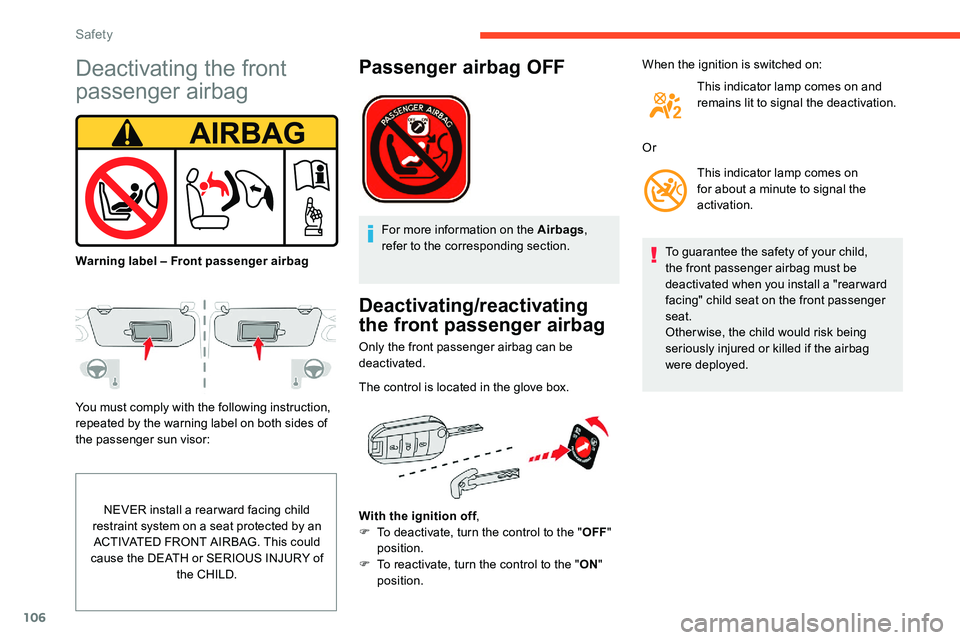
106
Deactivating the front
passenger airbag
You must comply with the following instruction,
repeated by the warning label on both sides of
the passenger sun visor:NEVER install a
rear ward facing child
restraint system on a
seat protected by an
ACTIVATED FRONT AIRBAG. This could
cause the DEATH or SERIOUS INJURY of the CHILD.
Passenger airbag OFF
For more information on the Airbags ,
refer to the corresponding section.
Deactivating/reactivating
the front passenger airbag
Only the front passenger airbag can be
deactivated.
The control is located in the glove box.
With the ignition off ,
F
T
o deactivate, turn the control to the " OFF"
position.
F
T
o reactivate, turn the control to the " ON"
position.
Warning label – Front passenger airbag
To guarantee the safety of your child,
the front passenger airbag must be
deactivated when you install a "rear ward
facing" child seat on the front passenger
seat.
Otherwise, the child would risk being
seriously injured or killed if the airbag
were deployed.
When the ignition is switched on:
This indicator lamp comes on and
remains lit to signal the deactivation.
Or This indicator lamp comes on
for about a minute to signal the
activation.
Safety
Page 109 of 292

107
Child seat at the rear
"Rearward facing " and
" Forward facing "
When a "rear ward facing" or "for ward facing"
child seat is installed on a
rear passenger
seat , move the vehicle's front seat for ward and
straighten the backrest so that the legs of the
child in the "for ward facing" or the "rear ward
facing" child seat do not touch the vehicle's
front seat.
Centre rear seat
A child seat with a support leg must never be
i nstalled on the centre rear passenger seat .
The incorrect installation of a
child seat in
a
vehicle compromises the protection of
the child in the event of an accident.
Summary table for installation of universal, ISOFIX and
i-Size child seats
As required by European regulations, this table gives the options for installing child seats secured
using the seat belt and universally approved (a) as well as the larger ISOFIX and i-Size child seats
on seat positions equipped with ISOFIX mountings in the vehicle.
Seat numbers
Front seats Rear seats
1 3
(b), (c), (e) 4
56
3 1
(b), (c), (e) 4
56
Position compatible with
a
universal (a) child seat noyes
(f ) yes yes yes
Position compatible with an i-Size child seat no
yes yes noyes
Position equipped with a
TOP
TETHER fixing no
yes yes noyes
" Carr ycot " type of child seat no no no no no
"Rearward facing" ISOFIX child
seat noR3
(d) R2
noR2
"For ward facing" ISOFIX child
seat noF3
(d) F3
noF3
5
Safety
Page 110 of 292
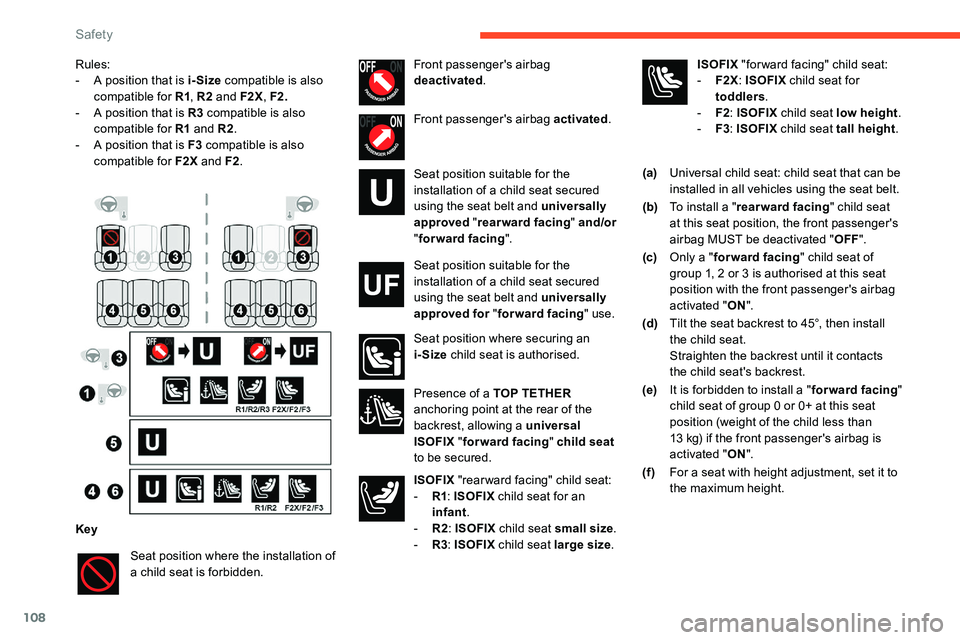
108
Rules:
- A p osition that is i-Size compatible is also
compatible for R1 , R2
and F2X, F2.
-
A p
osition that is R3
compatible is also
compatible for R1
and R2.
-
A p
osition that is F3
compatible is also
compatible for F2X and F2.
(a)Universal child seat: child seat that can be
installed in all vehicles using the seat belt.
(b) To install a " rearward facing " child seat
at this seat position, the front passenger's
airbag MUST be deactivated " OFF".
(c) Only a " forward facing " child seat of
group 1, 2
or 3 is authorised at this seat
position with the front passenger's airbag
activated " ON".
(d) Tilt the seat backrest to 45°, then install
the child seat.
Straighten the backrest until it contacts
the child seat's backrest.
(e) It is forbidden to install a " forward facing"
child seat of group 0
or 0+ at this seat
position (weight of the child less than
13
kg) if the front passenger's airbag is
activated " ON".
(f ) For a
seat with height adjustment, set it to
the maximum height.
Key Seat position where the installation of
a
child seat is forbidden. ISOFIX
"forward facing" child seat:
- F2 X: ISOFIX child seat for
toddlers .
-
F2:
ISOFIX child seat low height .
-
F3:
ISOFIX child seat tall height .
Front passenger's airbag
deactivated
.
Front passenger's airbag activated .
Seat position suitable for the
installation of a
child seat secured
using the seat belt and universally
approved " rearward facing " and/or
" forward facing ".
Seat position suitable for the
installation of a
child seat secured
using the seat belt and universally
approved for " forward facing " use.
Seat position where securing an
i-Size child seat is authorised.
Presence of a
TOP TETHER
anchoring point at the rear of the
backrest, allowing a
universal
ISOFIX " forward facing " child seat
to be secured.
ISOFIX "rearward facing" child seat:
-
R
1: ISOFIX child seat for an
infant .
-
R2:
ISOFIX child seat small size .
-
R3:
ISOFIX child seat large size .
Safety